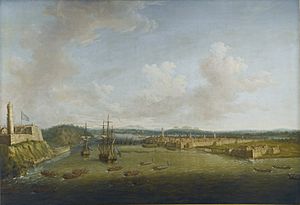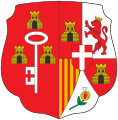Captaincy General of Cuba facts for kids
Quick facts for kids
Captaincy General of Cuba
Capitanía General de Cuba
|
|||||||||
|---|---|---|---|---|---|---|---|---|---|
| 1607–1898 | |||||||||
|
|
|||||||||
|
Anthem: National anthem of Spain
|
|||||||||

Viceroyalty of New Spain in 1794, with the Captaincy General of Cuba shown in purple
|
|||||||||
| Status | Captaincy General | ||||||||
| Capital | Havana | ||||||||
| Common languages | Spanish | ||||||||
| Religion | Roman Catholicism | ||||||||
| Government | Monarchy | ||||||||
| King | |||||||||
|
• 1759–1788
|
Charles III | ||||||||
|
• 1886–1898
|
Alfonso XIII Maria Christina of Austria (Regent) |
||||||||
| Captain General | |||||||||
|
• 1764–1779
|
Count of Ricla | ||||||||
|
• 1887–1898
|
Ramón Blanco y Erenas | ||||||||
| Historical era | Early modern Europe | ||||||||
|
• Administrative reorganisation
|
1607 | ||||||||
| December 10 1898 | |||||||||
| Currency | Spanish dollar, Spanish peseta | ||||||||
| ISO 3166 code | CU | ||||||||
|
|||||||||
| Today part of | Cuba | ||||||||
The Captaincy General of Cuba (Spanish: Capitanía General de Cuba) was a special administrative area of the Spanish Empire. It was created in 1607 by Spain to better protect and manage its lands in the Caribbean Sea. Similar areas were also set up in Puerto Rico, Guatemala, and Yucatán.
In 1764, the Captaincy General was reorganized. This was part of bigger changes called the Bourbon Reforms. These changes gave Cuba more control over its own affairs. They also added Florida and Louisiana to Cuba's territory. A new leader, called the Governor-Captain General, was based in Havana. He managed the new district. Before this, local governors reported to a court in Santo Domingo. This court still handled legal matters until new courts were created in Puerto Príncipe (1800) and Havana (1838).
By 1825, Spain had lost most of its American colonies. So, the Spanish government gave the governors of Cuba special powers. These powers covered administration, justice, and money matters. In the late 1800s, these governors were given the title of Governor General.
Contents
History of Cuba's Spanish Rule
Early Days of Spanish Control
Since the 1500s, the island of Cuba was managed by the governor of Santo Domingo. This governor was also the head of the main court there. He oversaw Cuba's local governor. The Santo Domingo court also heard appeals from Cuba.
In 1510, Diego Colón, the Viceroy of the Indies, sent Diego Velázquez de Cuéllar to conquer Cuba. Velázquez became Cuba's first governor. The new settlers did not want to be under Colón's direct rule. So, Velázquez founded the city of Baracoa in 1511. He then called a local council, called a cabildo. This council was allowed to talk directly with Spain. This move helped Velázquez and the settlers avoid Colón's authority.
Other cities were founded by Velázquez. These included Bayamo (1513), Santísima Trinidad, Sancti Spíritus, and San Cristóbal de La Habana (1514). Also, Puerto Príncipe and Santiago de Cuba (1515). After the Spanish conquest of the Aztec Empire, many settlers left Cuba. This meant Cuba's population stayed small for about 200 years.
In 1565, Pedro Menéndez de Avilés founded San Agustín in Florida. This made Florida part of Cuba's administration. However, because of the distance, Florida's government could talk directly with Spain.
The Church was very important in Spanish America. Governors, representing the King, oversaw church matters. This was because the King had the right to appoint church leaders. So, the church and state were closely linked. The first diocese (church area) was set up in Baracoa in 1518. Its main church was in Seville, Spain. The diocese moved to Santiago de Cuba in 1522. In 1546, the Diocese of Santo Domingo became an Archdiocese. Santiago de Cuba then reported to it.
How the Captaincy General Was Created
In 1607, Philip III of Spain created the Captaincy General of Cuba. This was part of a plan to protect the Caribbean from pirates and other threats. The first captain general was Pedro Valdés. Around this time, similar captaincies were made in Puerto Rico (1580) and Central America (1609). Cuba was split into two areas, with capitals in Havana and Santiago de Cuba. The governor of Havana was the Captain General for the whole island. In 1650, many Spanish settlers came to Cuba. They were refugees from Jamaica, which the English had captured.
In 1756, Spain started building ships for its navy in Havana. A royal shipyard was set up there.
The British capture of Havana in 1762 was a big moment for Cuba. It happened during the Seven Years' War. The British took Havana after a three-month fight. They controlled the western part of the island for a year. Britain gave Cuba back to Spain in exchange for Florida in the Treaty of Paris. This event showed how weak Cuba's defenses were. It also showed how Spain had not paid enough attention to Cuba's economy. During the year they controlled Cuba, the British traded a lot with the island. This was more trade than Cuba had ever seen.
Spain took the problems seriously. The same year they got Havana back, they started building a huge fort. This fort, San Carlos de la Cabaña, was on the east side of Havana's harbor. It became the largest Spanish fort in the New World.
The Bourbon Reforms and Cuba's Growth
Starting in 1764, Cuba's government was completely changed. Alejandro O'Reilly wrote a report about the island. This report led to many new changes. More military leaders were chosen to be governor-captain general of Cuba. Many of them later became Viceroys of New Spain. To help the captain general of Cuba, the governor of Santiago was also made a captain general. He commanded the military forces in his area.
A new system was also brought to Cuba: the intendancy. An intendencia was set up in Havana. It managed government and military spending. It also worked to improve the local economy. The first Intendant, Miguel de Altarriba, arrived in 1765. Other intendancies soon followed in Louisiana (1766), Puerto Príncipe (1786), and Santiago de Cuba (1786). In 1774, the first census of Cuba was done. It showed 171,670 people lived on the island. Other steps were taken to boost the economy.
These changes, especially the intendancy system, greatly changed Cuba. The island went from being a defensive outpost to a rich colony. It grew sugar, coffee, and tobacco for export. This also meant many slaves were brought to Cuba. The island's farming economy grew even more. This happened as Cuban ports slowly opened to foreign ships. This was especially true after Spain lost its mainland colonies.
Changes in Territory and the Church
During the American Revolutionary War, Spain took back Florida from Great Britain. This was confirmed in the 1783 Treaty of Paris. But within about 35 years, the United States gained all this land. This was partly due to arguments over borders.
In 1795, Spain gave its part of Santo Domingo to France. This was part of the Treaty of Basel. This made Cuba the most important Spanish land in the Caribbean. The main court from Santo Domingo moved to Santa María del Puerto Príncipe five years later.
The Church also grew. In 1787, a new church area, the Diocese of San Cristóbal de La Habana, was created. It included Florida and Louisiana. In 1793, the Diocese of Louisiana and the Two Floridas was set up. Both reported to the Archdiocese of Santo Domingo. But after the Treaty of Basel, Santo Domingo's archdiocese disappeared. So, Santiago de Cuba became an Archdiocese. The dioceses of Havana, Louisiana, and Puerto Rico then reported to it.
Cuba in the 1800s
The Spanish Constitution of 1812 said that Cuba was a full part of Spain. It became a province with its own elected local council. Cities also got their own elected councils. These councils worked when the Constitution was in force (1812-1814 and 1820-1823). But the Constitution was later cancelled by Ferdinand VII of Spain.
When Ferdinand VII died, new changes happened. Spain's government became more liberal. However, it decided that overseas lands like Cuba were colonies. They would be ruled by special laws. The democratic councils set up by the 1812 Constitution were removed. The new Constitution of 1837 confirmed Cuba's lower status. But these "special laws" for colonies were not written until 1865. Even then, their ideas were never made into actual laws.
In the 1830s, legal matters were reorganized. A new court, the Audiencia of Havana, was created in 1838. The court in Puerto Príncipe then only handled cases in the east and center of the island.
In 1851, an attempt by American adventurers, called filibustering, to take Cuba failed. Many of them were executed. Three years later, some American diplomats discussed buying Cuba from Spain. This idea was called the Ostend Manifesto. They even talked about taking Cuba by force.
By the mid-1800s, a strong movement for Cuba's independence grew. Cuba had three civil wars in 30 years. These were the Ten Years' War (1868–78), the Little War (1879–80), and the War of Independence. The War of Independence later became the Spanish–American War. During this last war, the issue of Cuba's self-rule became very important. In 1897, Spain's government created a special document. It was called the Constitución Autonómica. This document gave the Caribbean islands self-rule. This technically ended the Captaincy General. The new government for Cuba was to have an "Island Parliament" and a "Governor-General." This new government worked for only a few months. Then, the United States took control of the island.
Images for kids
See also
 In Spanish: Capitanía General de Cuba para niños
In Spanish: Capitanía General de Cuba para niños
- List of colonial governors of Cuba
- Piracy in the Caribbean
- British expedition against Cuba
- History of Cuba







